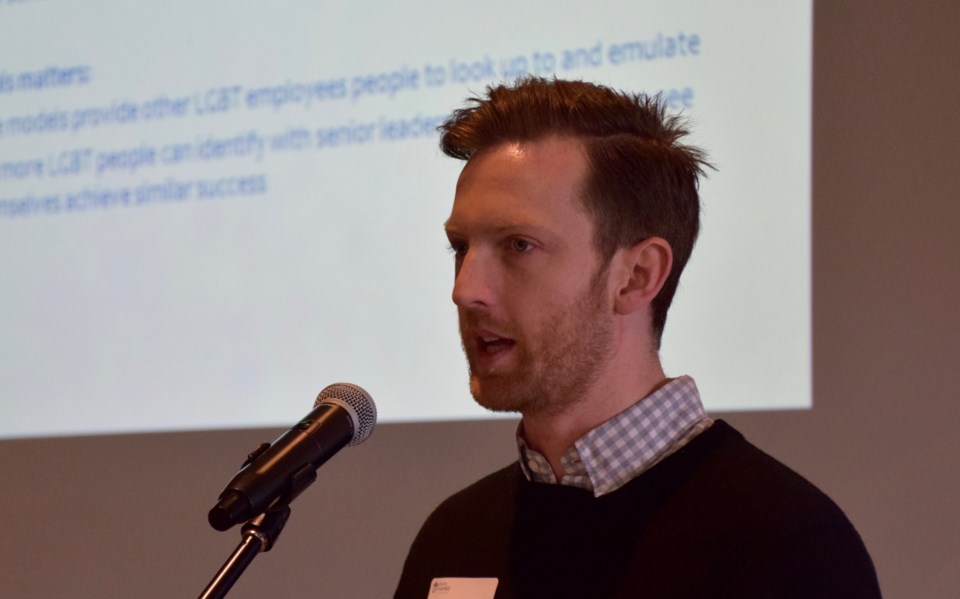When it comes to including lesbian, gay, bisexual and transgender (LGBT) people in the workplace, the most important thing to remember is that each individual is unique, and each is deserving of the utmost respect and dignity.
Colin Druhan, the executive director of Pride at Work, gave about 40 business people a crash-course in the many factors that make for diversity and inclusivity in the workplace, as it relates to LGBT employees. Druhan was the guest speaker at a Guelph Chamber of Commerce Lunch and Learn event Wednesday.
He told the audience that it is in the best interest of the business community to have LGBT-friendly and inclusive workplaces. The LGBT community has an annual economic impact in this country of over $100 billion.
But LGBT employees tend not to experience the same degree of respect as those who identify as heterosexual or cisgender – cisgender meaning one who identifies with the gender that was assigned at birth.
A Pride at Work survey, Druhan said, found that 67 per cent in the heterosexual/cisgender group experienced no discrimination in the workplace, while 62 percent of LGBT-identified employees either experienced or witnessed discrimination.
LGBT identified individuals experience higher levels of depression and anxiety, and have higher incidents of suicide, he said. And the discriminatory treatment they receive from others, including in the workplace, contributes to those statistics.
“People should feel safe at their job, not afraid of being shamed or harmed,” he said.
But many LGBT employees choose not to reveal their sexual orientation in their workplace, thinking it will make co-workers uncomfortable, or alienate them. Some fear retaliation.
Druhan told the story of his first job, one he received at a fast-food establishment in Nova Scotia when he was 16. He worked in the back of the café, and didn’t interact with the public. He was a diligent, high-performing employee.
He said he loved to work, worked hard, and was always eager to learn new things, and have additional responsibilities. But when he asked his employer if he could work up front serving customers, he was told that his voice was “too gay,” and that wasn’t the sort of image the business wanted to project.
“I couldn’t do something I wanted to do because of who I was,” he said.
Druhan then went at a rapid-fire pace into what he called a “LGBT 101” lesson, in an effort to instill an understanding of the terminology that is generally accepted, and that which is not appropriate to use in the workplace.
It’s essential, he said, to have an understanding of three related, but fundamentally different grounds on which employment protections for LGBT people are based. Those include sexual orientation, gender identity and gender expression. Understanding the difference between them ensures a greater level of inclusivity and understanding in the workplace.
Sexual orientation, he said, relates to one’s intimate emotional, romantic and/or sexual feelings towards other people - an internal sense of one’s attraction that is not defined by sexual behaviour or history.
Gender identity refers to one’s individual and internal sense of gender – the experience of being male, female, both, or neither. And gender expression is the way in which each person presents gender to other people, whether through outward appearance, body language, the use of he or she pronouns. Gender expression does not always reflect gender identity.
Any meaningful discussion on the issue of LGBT inclusion and acceptance in the workplace must begin with an understanding of these three terms, he said, because that understanding contributes to acceptance and understanding, and to a culture of diversity in the workplace.
Bruhan sped through a host of terms and their definitions – starting with LGBT, and other similar abbreviations currently in use. While some organizations, institutions, and groups use LGBTQI (lesbian, gay, bisexual, transgender, queer and intersex), and others use LGBTTIQQ2SA (lesbian, gay, bisexual, transgender, transsexual, intersex, queer, questioning, 2-spirit and asexual), Pride and Work prefers to keep it simpler.
“There is no LGBT UN that says these are the initials to use,” he said. “A lot of different groups use different initials. But what we have in common is that we are all different as human beings.”
Terms and definitions are ever-changing, he indicated. It’s important to be mindful of and sensitive to those changes.
He said the term “homosexual” is no longer an appropriate term, given its clinical overtones, and its purely physical connotations. Relationships between lesbians, gays, bisexual and transgender people, he said, go far beyond the physical.
While the term “queer” may be widely used in Canada, and accepted by a younger generation, it is still a pejorative term in some areas of the country, and in other countries around the word. He advised caution in using it.
Pride at Work was founded in 2008 by individuals who wanted to improve the climate of inclusiveness for LGBT employees in Canadian workplaces. It now has dozens of regional and national partners, including many major companies that are committed to fostering inclusive work environments for LGBT Canadians.
